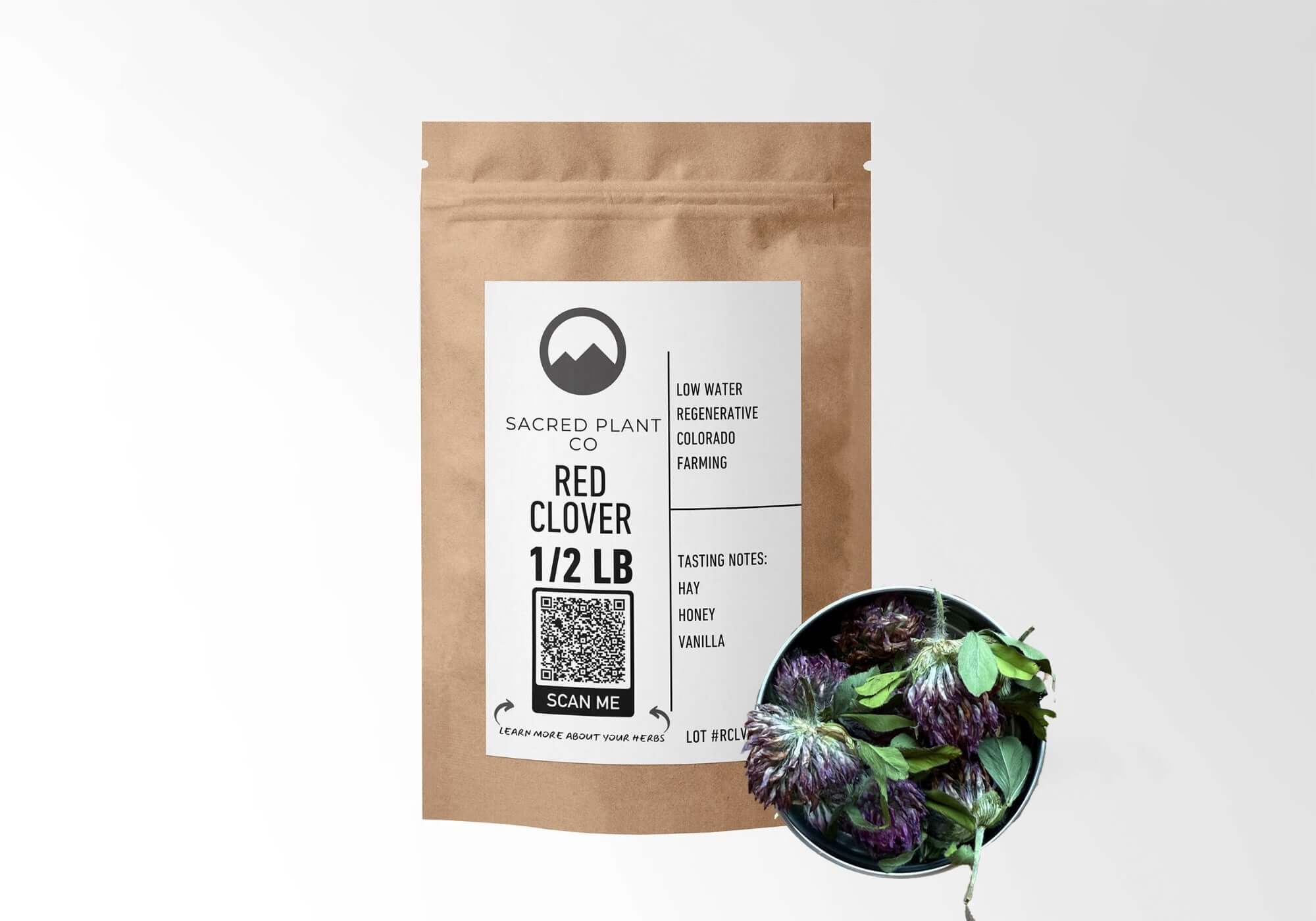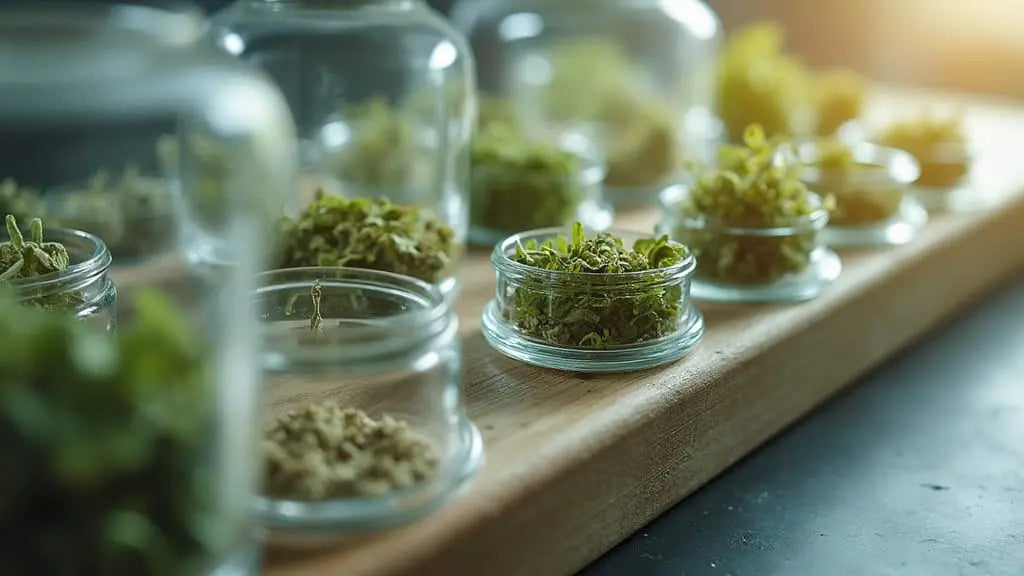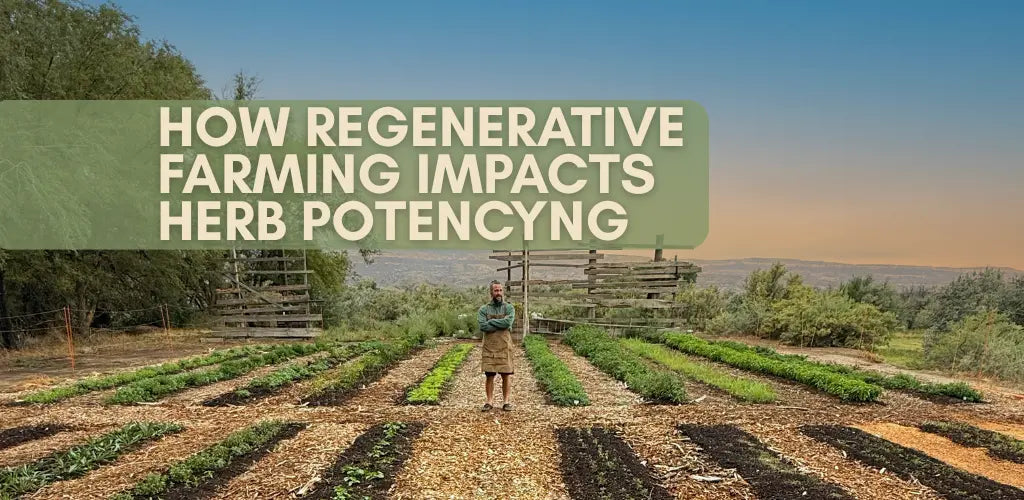How to Harvest Red Clover Sustainably
Red clover (Trifolium pratense) is more than a wildflower, it’s a teacher. For generations, this humble blossom has offered its vibrant petals to teas, tinctures, and tonics that support detoxification, hormone balance, and respiratory strength. But its medicine begins long before the jar, it begins in the field.
In this guide, you’ll learn how to harvest red clover sustainably, with respect, precision, and purpose. We’ll walk you through the ideal red clover blossom harvest time, the art of hand-picking red clover without damaging its roots or rhythms, and the methods we use at Sacred Plant Co to dry blossoms for tea in a way that preserves both potency and spirit.
At the heart of it all is a belief in ethical wildcrafting. True herbalism isn’t extractive, it’s reciprocal. Every harvest should leave the patch stronger, every hand-picked flower should reflect care, and every drying rack should tell the story of regenerative herb farming at work.
Whether you're an herbalist, a forager, or a conscious consumer, this isn’t just a guide, it’s an invitation to join us in a deeper practice: one that honors the land, the lineage, and the plant itself.
Understanding Red Clover’s Life Cycle
To sustainably harvest red clover, we must first understand the life it leads. Trifolium pratense is a short-lived perennial or biennial legume that thrives in open meadows, field edges, and wild margins where the soil is loose, the sun abundant, and competition minimal. It begins by spreading low to the ground, gradually building strength, and eventually sending up its iconic rosy-purple blossoms. Each flower signals that the soil beneath is healing and the surrounding ecosystem is in balance.
Red clover is not just another wildflower. It plays a vital role in regenerative herb farming. As a nitrogen fixer, it enriches soil naturally, supports pollinators, and improves the land with each cycle. Its presence brings fertility and vitality to the farm, making it a cornerstone of sustainable agriculture.
At Sacred Plant Co, we align our harvests with the plant’s natural rhythms and the needs of the soil. Its root systems build resilience underground while the blossoms rise in seasonal waves. Timing is everything. Understanding the plant’s full cycle is key to identifying the ideal red clover blossom harvest time. Harvesting too early can interrupt reproduction and weaken future growth. Waiting too long can result in wilted blossoms with diminished potency.
Harvesting red clover ethically means more than just picking flowers. It means entering a rhythm of respect and reciprocity, one that begins with knowing when the plant is ready and ends with leaving the patch stronger than we found it.
Red Clover Blossom Harvest Time

If you're learning how to harvest red clover sustainably, the most important place to begin is with timing. The ideal red clover blossom harvest time is when the plant is in full bloom, bright, plump, and vibrantly magenta, with no signs of browning or dryness. This peak moment usually falls in late spring to early summer, though a second flush may appear in early fall depending on your region.
Harvesting is best done mid to late morning, after the dew has lifted but before the heat of the day sets in. At this hour, the blossoms are cool and slightly pliable, their fragrance carried lightly on the breeze. Touch them, and you’ll feel the softness still held from the night air. Pick too early, and moisture may ruin the drying process. Pick too late, and volatile compounds may already be lost to the sun.
At Sacred Plant Co, our practice of hand-picking red clover involves moving slowly through the fields, selecting only the fullest, healthiest flower heads. We leave any blossoms that are beginning to fade, allowing them to nourish pollinators or go to seed naturally. This is part of our commitment to ethical wildcrafting red clover, where we take only what the land offers freely and never more than it can recover from.
In cooler, high-altitude climates, blooms may arrive weeks later than in warmer regions. Pay attention to local patterns and let observation guide you more than the calendar. A truly sustainable harvest respects the rhythm of the land.
We believe every red clover field speaks, if you listen, and when you do, the timing becomes not just a technical step, but an act of reverence.
Ethical Wildcrafting Red Clover
Ethical wildcrafting is the heart of how to harvest red clover sustainably. At Sacred Plant Co, it’s more than a practice, it’s a promise. Every red clover patch is part of a living relationship between soil, pollinators, weather, and time. To wildcraft ethically means to enter that relationship gently, with humility and care.
Harvesting this way is more like listening to a piece of music than following a set of instructions. The rhythm of the field tells you when to step in, when to wait, and when to leave it untouched entirely.
We follow what we call The Sacred Plant Co Method for Ethical Red Clover Harvesting, rooted in three essential principles:
1. Take Less Than You Leave
We never harvest more than one-third of any patch. This ensures there is enough left for pollinators, for seed production, and for the plant itself to continue regenerating. If a patch is sparse or under stress, we don’t harvest at all.
2. Rotate with Intention
Our harvesting routes change with the seasons and across years. We return only when we know the land has recovered. This avoids pressure on any one area and allows for a healthier, more diverse ecosystem.
3. Choose Only What Is Ready
We hand-pick only the most vibrant blossoms, full in color and structure. Flowers that are wilted, insect-damaged, or overly mature are left to the bees or the soil. This selectivity ensures that the blossoms we dry for tea retain their full therapeutic potential.
These steps may seem slow, but they are powerful. In regenerative herb farming, patience is a form of productivity. Observation is part of the harvest. Wildcrafting red clover ethically does not just protect the plant, it strengthens the entire system it grows in.
We believe every harvest should leave the land better than we found it. What would the world look like if every hand that reached for a flower did so with reverence?
Hand-Picking Red Clover: Technique and Tools
The method matters. In learning how to harvest red clover sustainably, the act of picking is just as important as the timing. Hand-picking allows for care, precision, and connection. It ensures that each blossom is selected at its peak and that the plant and surrounding patch remain undisturbed.
At Sacred Plant Co, we harvest red clover by hand not only because it yields a superior product, but because it honors the plant. Machines crush, strip, and take. Hands can choose, feel, and give back.
What You’ll Need
-
A sharp pair of herb scissors or your hands
-
A woven or breathable basket
-
Clean, dry clothes or linens for collecting blossoms (optional but ideal)
-
A shaded work surface to transfer the harvest before drying
We recommend harvesting without gloves. There is value in touch. You’ll learn to feel the difference between a full, supple blossom and one that’s past its prime.
How to Pick
Gently grasp the base of the flower head, just above the cluster of top leaves. These leaves, often overlooked, are vital. They contain additional medicinal compounds that support the synergy of the herb. Always include them when harvesting.
Snip or pinch the blossom cleanly, taking care not to tug or tear. Never pull from the root. With each pick, scan the plant. Is it healthy? Is it part of a thriving stand? If not, let it be.
This is the rhythm of hand-picking red clover—a deliberate pace, a mindful presence, and a respect for what remains.
Each flower chosen with care becomes part of a deeper story. One of regeneration, intention, and trust between the gatherer and the green world.
Drying Red Clover for Tea

Once the blossoms are gathered, the next step in how to harvest red clover sustainably is just as important: proper drying. This stage preserves the delicate compounds that make red clover so cherished in herbal tea and ensures the integrity of your harvest is carried through to the cup.
At Sacred Plant Co, we treat this step as a ritual—an act of stewardship and precision.
Where and How to Dry
Spread your blossoms in a single layer on a breathable surface. Ideal options include:
-
Mesh drying screens
-
Baskets lined with unbleached cotton
-
Paper towels or parchment on a shaded rack
Always choose a well-ventilated space out of direct sunlight. Red clover’s color and medicinal quality can degrade quickly when exposed to heat or UV rays. The goal is slow, even drying. Depending on humidity, this process usually takes three to seven days.
As they dry, the blossoms will shrink and darken slightly. They should feel crisp but not brittle. Over-dried red clover can lose aroma and potency. Under-dried blossoms risk mold in storage.
What to Avoid
-
Sun-drying on hot surfaces, which leaches phytochemicals
-
Stacking blossoms too thickly, which traps moisture
-
Sealing before fully dry, which creates mold risk
-
Drying in plastic containers, which inhibit airflow
How to Store
Once fully dry, store your red clover in an airtight glass jar, ideally dark or amber-colored. Keep it in a cool, dry place away from sunlight and moisture. Label your jar with the date and location of harvest. Herbal potency fades over time, so use within one year for the best results.
Drying red clover for tea is more than preservation—it is transformation. A well-dried blossom carries the warmth of the sun, the breath of the soil, and the care of the hand that picked it. When you steep it later, you’ll taste more than tea. You’ll taste trust.
Sacred Plant Co’s Regenerative Approach

At Sacred Plant Co, sustainability is only the beginning. Our work with red clover is grounded in regenerative herb farming, a philosophy that goes beyond doing less harm and seeks to actively restore the land, deepen biodiversity, and build long-term resilience into every harvest.
Red clover is more than a product. It is a partner. This remarkable plant does more than provide blossoms for tea. Its deep root systems aerate the soil, its nitrogen-fixing abilities nourish surrounding crops, and its flowers support a thriving pollinator population. Integrating red clover into our fields helps reduce the need for external inputs, revitalize depleted soil, and create healthier growing conditions for years to come.
We don’t harvest in spite of this ecological role, we harvest in alignment with it.
Our hand-picking red clover method allows us to leave the plant structure intact. We never use machines, never apply chemicals, and never take more than the land can offer. Our fields are walked, not driven. Every harvest is guided by close observation of soil, bloom patterns, and weather cycles. When a stand needs time to recover, we let it rest. When blossoms appear with abundance, we give thanks and proceed with care.
Each step of our process, from blossom to jar, reflects our deep belief that how to harvest red clover sustainably begins with reciprocity. The land gives us medicine, and we give it our attention, our respect, and our time.
Regenerative herbalism is not just about better farming. It is about creating a future where healing plants grow in healing soil—where the way we work with nature becomes part of the medicine itself.
Cultural and Historical Context

Long before red clover was dried for tea or bottled into tinctures, it held meaning. Across continents and cultures, Trifolium pratense has been revered not just as a remedy, but as a symbol—of fertility, of vitality, of protection. To understand how to harvest red clover sustainably is also to understand the legacy we inherit every time we bend to gather a blossom.
In traditional European herbalism, red clover was often called “bee bread” for its importance to pollinators and “cleansing clover” for its role in purifying the blood. Midwives and herbalists used it in women’s health formulations, believing it helped move stagnation and restore hormonal balance. In Ireland and parts of the British Isles, red clover fields were considered enchanted, often tied to faery folklore and the changing of seasons.
Native American communities also held red clover in esteem, especially as a smoke herb and a support for respiratory conditions. It was burned ceremonially in some regions and used in poultices or decoctions for general cleansing and vitality. Though preparations and meanings varied by tribe, the plant’s resilience and abundance made it a valued ally.
In Traditional Chinese Medicine, red clover has been more recently incorporated into modern formulas as a cooling herb that supports circulation and detoxification. While not historically native to East Asia, it has earned a place in contemporary global herbalism for its adaptable, multi-faceted qualities.
At Sacred Plant Co, we honor this mosaic of tradition. We believe that ethical wildcrafting red clover is a way of participating in something ancient. Each hand-picked blossom carries with it not just medicinal compounds, but centuries of stories and sacred uses.
We are not the first to harvest red clover, and we work every day to ensure we will not be the last.
Red Clover at Sacred Plant Co
At Sacred Plant Co, red clover is not just a crop, it is part of our identity. We don’t grow it to fill shelves. We cultivate it to fulfill a promise: that the herbs we offer are grown, harvested, and handled with unmatched care.
Our red clover is hand-tended in small, carefully managed plots where it plays a vital role in our broader system of regenerative herb farming. These fields are never sprayed, tilled, or mechanically harvested. Instead, each stand is observed through its full life cycle, and only harvested when the timing and conditions are ideal.
We follow the same principles we teach, rotating harvest areas, never taking more than a third, and including the top leaves beneath the flower head, which carry additional plant compounds often lost in large-scale operations. This detail, though small, makes a profound difference in the depth and breadth of the final product.
Each blossom is selected by hand, then dried slowly and carefully for tea, preserving its vibrant color and sweet, slightly earthy aroma. The result is a red clover offering that retains not only its herbal potency, but also the subtle signature of where it came from, soil, air, and season all held within the jar.
Our customers often tell us it’s the best red clover they’ve ever worked with. We believe that’s because it isn’t just picked. It’s respected.
When you choose red clover from Sacred Plant Co, you are not just purchasing an herb. You are participating in a cycle of care, a continuation of ethical wildcrafting, conscious stewardship, and ancient knowledge rooted in the soil beneath our feet.
To truly learn how to harvest red clover sustainably is to step into a deeper way of seeing the world, where every hand-picked flower becomes an act of reciprocity, and every decision in the field echoes through the ecosystem. This isn’t just about gathering herbs. It’s about participating in a living tradition, where intention matters as much as method, and where sustainability is measured not by what we take, but by what we leave behind.
We hope this guide has given you the tools to approach red clover with care, timing, and respect. Whether you're harvesting for your own tea, teaching others about ethical wildcrafting red clover, or looking to deepen your relationship with land and plant, your choices matter.
At Sacred Plant Co, we walk this path every day, hand-picking red clover at peak red clover blossom harvest time, drying it slowly for tea, and ensuring that our commitment to regenerative herb farming is more than just words. It’s our way of life.
If you’re ready to experience what conscious herbalism truly tastes like, we invite you to try our hand-harvested, chemical-free red clover. You'll find more than a product. You'll find a practice.
🌱 Explore Sacred Plant Co's Red Clover
Let every harvest be a step toward healing. For your body. For the earth. For the future.






